单元设计备课教案3BM2U1
- 格式:doc
- 大小:123.50 KB
- 文档页数:12
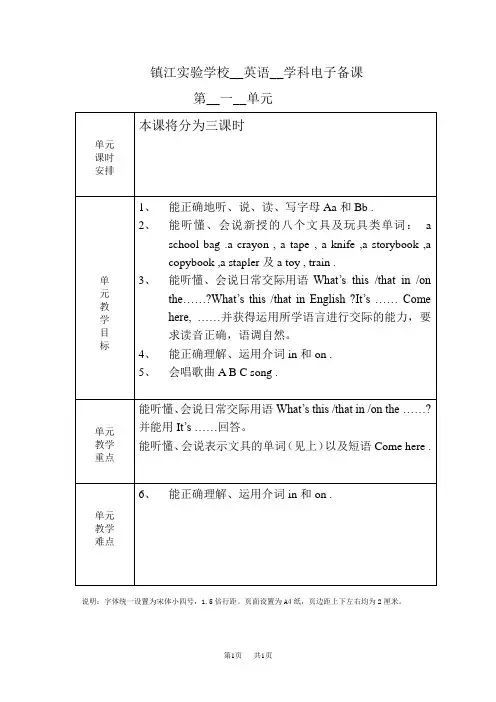
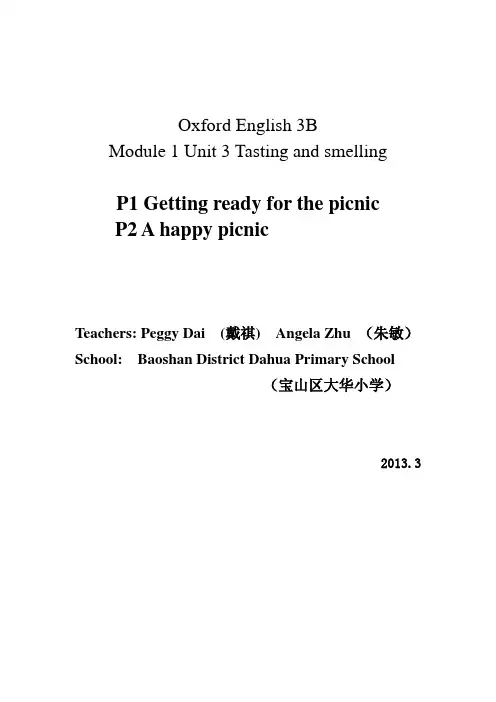
Oxford English 3BModule 1 Unit 3 Tasting and smellingP1 Getting ready for the picnicP2 A happy picnicTeachers: Peggy Dai (戴祺) Angela Zhu (朱敏)School: Baoshan District Dahua Primary School(宝山区大华小学)2013.3单元目标知识目标1.学习与味觉相关词汇与代表食物,并能正确运用如:sweet,sweet, lemon, sour, salt, salty, coffee, bitter2.在语境中学习、理解并运用下列句型结构:Smell/ Taste the… How does it smell/taste? It’s…Smell/Taste the…(s). How do they smell/taste? They’re…能力目标在野餐时相互分享食物,进行询问并准确地描述食物的口味与特征。
….Smell/ Taste the… How does it smell/taste? It’s…Smell/Taste the…(s). How do they smell/taste? They’re…情感目标体验丰富食物带来不同嗅觉与味觉的愉悦。
感受准备野餐时的激动心情,在兴奋中加深情感的体验; 感受野餐时分享食物的快乐心情,体会生活的美好。
分课时目标单元文本第一课时Getting ready for the picnic -Good morning.–Good morning.-Can I help you?-May I have some apples, please?-Sure.-Taste this apple, please. How does it taste?-It’s sour.-Taste this. How does this apple taste?-It’s sweet.-Ben, let’s go to buy some salty food.-OK.-Can I help you?-May I have some salty food, please?-Sure. Taste this sausage. It’s salty.-Hmm…It’s yummy.-I want some drinks too.-Taste this orange juice. How does it taste?-It’s sweet. I want this.-Taste this Oolong tea. How does it taste?-Oh, it’s bitter. I don’t like it.第二课时A happy picnicIt’s Sunday. It’s a fine day. Kitty, Alice, Ben and Tom go out for a picnic. Now they’re in the park. They bring much food. They’re talking about the food.K: Hey, Alice! I have some fruit. Do you like fruit?A: Yes. And I like apples best.K: Ha ha! Look! I have an apple. Smell it. How does it smell?A: Hmm…It’s nice. I like it.K:Taste it. How does it taste?A: Hmm…It’s very sweet. It’s tasty.A: I have some fruit too. What fruit do I have? Let’s play a guessing game, OK?K: OK. I like playing guessing games.A: Close your eyes.Smell them. How do they smell?K: They’re nice.A: What are they?K: Are they grapes?A: Yes, they’re grapes.K: Now taste them. How do they taste?A: Oh, they’re so sweet. They’re tasty.B: Tom, here are many tasty foods. What do you like eating?T: Oh, some sausages! I like eating sausages. Smell them. Mmm…They’re so nice. B:Taste this sausage. How does it taste?T: Oh, it’s tasty but a little salty. I want some drinks.B: Do you want orange juice?T: No, thanks. I like drinking coffee. Look, I have white coffee. Smell it. It is nice. Let me taste it. Oh, it’s tasty. I like it.B: But don’t drink too much coffee. It’s not good for you.T: OK.Kitty, Alice, Ben and Tom share(分享)the food. They have a hap py picnic! They have a nice day!单课教学文本与教学过程Oxford English Book 3B (Shanghai Edition)Module 1 Unit3 Tasting and smelling (Period 1)Getting ready for the picnicSchool: Shanghai Baoshan District Dahua Primary School (大华小学) Teacher: 戴祺Teaching materials:Module 1 Unit3 Tasting and smelling (Period 2)A happy picnicSchool: Shanghai Baoshan District Dahua Primary School (大华小学) Teacher: 朱敏Teaching materials:。
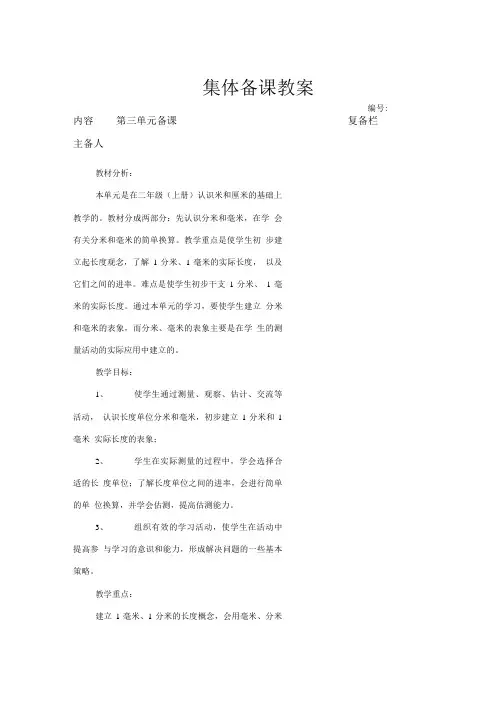
集体备课教案
编号:
复备栏
内容第三单元备课
主备人
教材分析:
本单元是在二年级(上册)认识米和厘米的基础上
教学的。
教材分成两部分:先认识分米和毫米,在学会
有关分米和毫米的简单换算。
教学重点是使学生初步建
立起长度观念,了解1分米、1毫米的实际长度,以及
它们之间的进率。
难点是使学生初步干支1分米、1毫
米的实际长度。
通过本单元的学习,要使学生建立分米
和毫米的表象,而分米、毫米的表象主要是在学生的测
量活动的实际应用中建立的。
教学目标:
1、使学生通过测量、观察、估计、交流等
活动,认识长度单位分米和毫米,初步建立1分米和1
毫米实际长度的表象;
2、学生在实际测量的过程中,学会选择合
适的长度单位;了解长度单位之间的进率,会进行简单
的单位换算,并学会估测,提高估测能力。
3、组织有效的学习活动,使学生在活动中
提高参与学习的意识和能力,形成解决问题的一些基本
策略。
教学重点:
建立1毫米、1分米的长度概念,会用毫米、分米
教学难点:
毫米、分米概念的形成和在实际测量中的灵活应用。
教学准备:学生尺、米尺、大约1分米长或1毫米厚的物品若干。
方法措施:
1、创设愉悦的学习情境,激发学生学习兴趣。
2、注重学生的自主探索与合作交流。
3、密切数学与生活的联系,加强知识的应用。
4、建立多元化的评价方式,激励学生学习。
课时安排:
1、认识分米和毫米............ 1课时
2、简单的单位换算1课时。
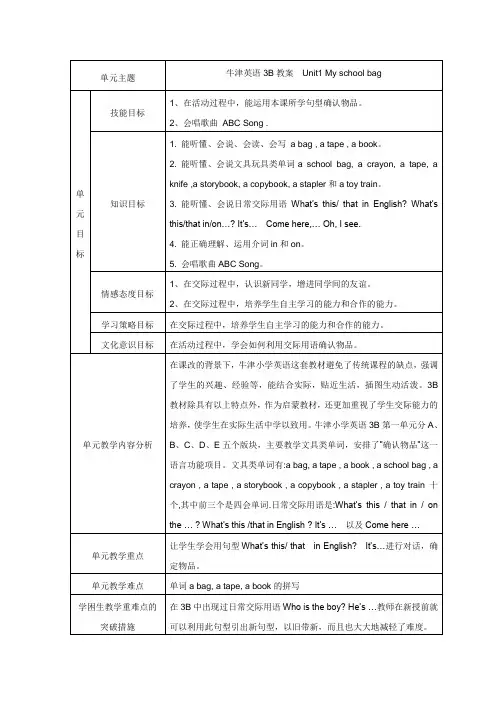
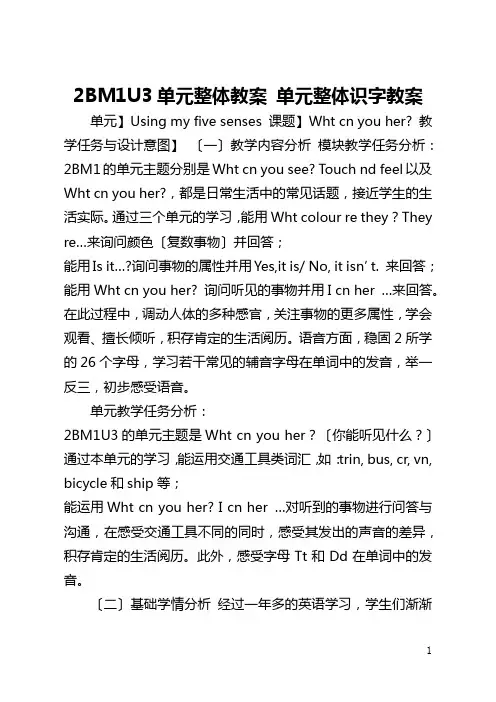
2BM1U3单元整体教案单元整体识字教案单元】Using my five senses 课题】Wht cn you her? 教学任务与设计意图】〔一〕教学内容分析模块教学任务分析:2BM1的单元主题分别是Wht cn you see? Touch nd feel以及Wht cn you her?,都是日常生活中的常见话题,接近学生的生活实际。
通过三个单元的学习,能用Wht colour re they?They re…来询问颜色〔复数事物〕并回答;能用Is it…?询问事物的属性并用Yes,it is/ No, it isn’t. 来回答;能用Wht cn you her? 询问听见的事物并用I cn her …来回答。
在此过程中,调动人体的多种感官,关注事物的更多属性,学会观看、擅长倾听,积存肯定的生活阅历。
语音方面,稳固2所学的26个字母,学习若干常见的辅音字母在单词中的发音,举一反三,初步感受语音。
单元教学任务分析:2BM1U3的单元主题是Wht cn you her?〔你能听见什么?〕通过本单元的学习,能运用交通工具类词汇,如:trin, bus, cr, vn, bicycle和ship等;能运用Wht cn you her? I cn her …对听到的事物进行问答与沟通,在感受交通工具不同的同时,感受其发出的声音的差异,积存肯定的生活阅历。
此外,感受字母Tt和Dd在单词中的发音。
〔二〕基础学情分析经过一年多的英语学习,学生们渐渐适应了小学的学习生活。
大多数学生学习兴趣深厚、课堂活动参加主动,良好的学习习惯也在渐渐养成。
他们求知欲强,擅长仿照,喜爱听故事、唱儿歌、做游戏、肢体表演等活动形式,有较强的表现欲。
但是,部分学生的留意力集中还不够长久,观看习惯与倾听习惯也有待进一步训练。
在学习本单元内容之前,学生学习了有关动物的单词,如snke, frog等;学习了一些有关交通工具的单词,如:bicycle, cr和vn等;在句型方面,1BM1U2曾用Wht do you her? I her..来问答听到的物品;2M1U2曾用You’re ...和I’m ...来自我描述与描述对方......〔三〕设计意图第一课时,Ming来到城市中,听到了各种交通工具的声音,由此展开疑问,其间自然带出trin, bus, cr, vn, bicycle和ship等交通工具类词汇的学习,运用I cn her (I)goes...等进行描述和沟通,感受交通工具的不同,初步感受其发出的不同声音。
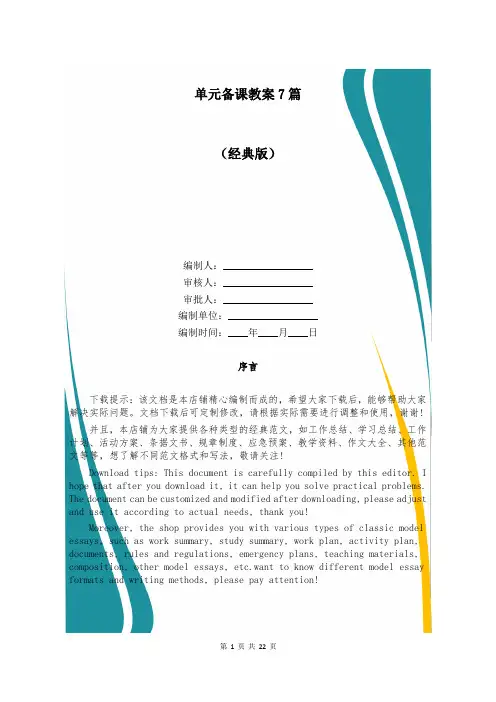
单元备课教案7篇(经典版)编制人:__________________审核人:__________________审批人:__________________编制单位:__________________编制时间:____年____月____日序言下载提示:该文档是本店铺精心编制而成的,希望大家下载后,能够帮助大家解决实际问题。
文档下载后可定制修改,请根据实际需要进行调整和使用,谢谢!并且,本店铺为大家提供各种类型的经典范文,如工作总结、学习总结、工作计划、活动方案、条据文书、规章制度、应急预案、教学资料、作文大全、其他范文等等,想了解不同范文格式和写法,敬请关注!Download tips: This document is carefully compiled by this editor. I hope that after you download it, it can help you solve practical problems. The document can be customized and modified after downloading, please adjust and use it according to actual needs, thank you!Moreover, the shop provides you with various types of classic model essays, such as work summary, study summary, work plan, activity plan, documents, rules and regulations, emergency plans, teaching materials, composition, other model essays, etc.want to know different model essay formats and writing methods, please pay attention!单元备课教案7篇教案的准备可以帮助我们更好地引导学生进行跨学科的综合学习,写教案是教师对教学过程进行规划和组织的重要环节,能够提高教师的自我管理能力,本店铺今天就为您带来了单元备课教案7篇,相信一定会对你有所帮助。
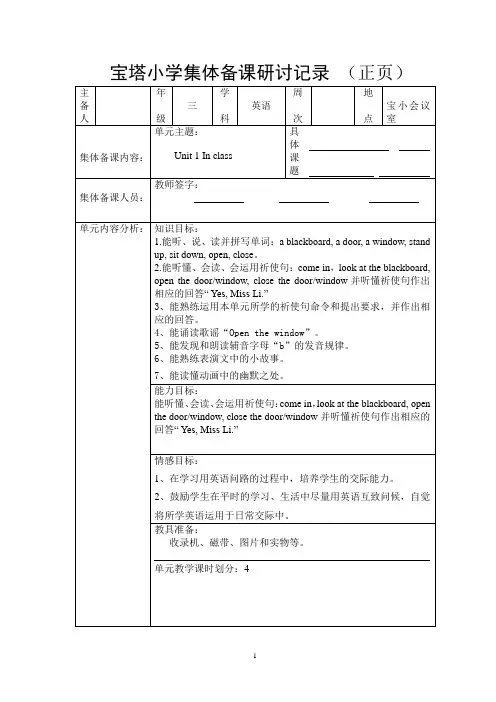
宝塔小学集体备课研讨记录(正页)
宝塔小学集体备课研讨教案第周
备注:请各备课组对照每期集体备课主题,仔细研讨,书写认真;内容详实,思路清晰,二轮备课要及时、充分,实用。
宝塔小学集体备课研讨教案第周
备课要及时、充分,实用。
宝塔小学集体备课研讨教案第周
备注:请各备课组对照每期集体备课主题,仔细研讨,书写认真;内容详实,思路清晰,二轮备课要及时、充分,实用。
宝塔小学集体备课研讨教案第周
备注:请各备课组对照每期集体备课主题,仔细研讨,书写认真;内容详实,思路清晰,二轮备课要及时、充分,实用。
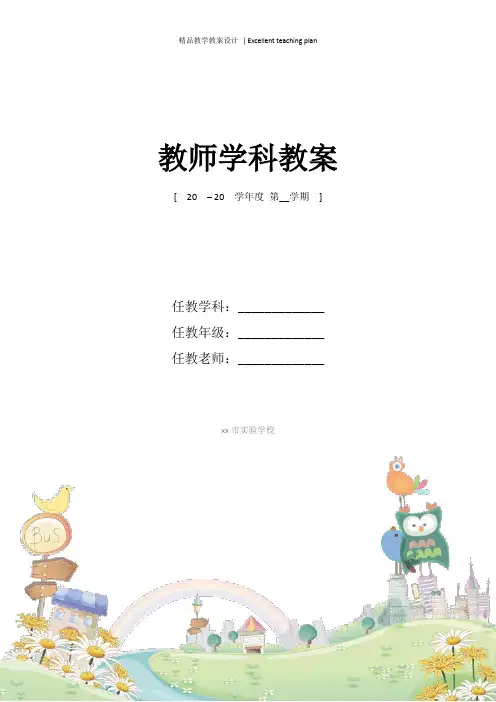
教师学科教案[ 20 – 20 学年度第__学期]任教学科:_____________任教年级:_____________任教老师:_____________xx市实验学校课题:Module 2 ExperiencesUnit 1 I’ve also entered lots of competitions.教学时间:2015年月日教师:一、教学目标(一)知识与技能:1、知识目标1)话题:节假日活动2)词汇:正确使用下列词语和词组:competition, ever,problem, wonderful, prize, take off 理解下列单词:reckon, brilliant3)语法:能够初步感知和运用现在完成时的用法如:Has she visited China before? Have you looked at today’s newspaper?4)语音:掌握现在完成时的疑问句及其回答。
5)功能:询问有关经历。
2、技能目标听:能够听懂含有现在完成时的对话2)词汇:正确使用下列词语和词组:competition, ever,problem, wonderful, prize, take off 理解下列单词:reckon, brilliant3)语法:能够初步感知和运用现在完成时的用法如:Has she visited China before? Have you looked at today’s newspaper?4)语音:掌握现在完成时的疑问句及其回答。
5)功能:询问有关经历。
(二)过程与方法:听:能够听懂含有现在完成时的对话(三)情感态度和价值观:谈论经历时能够注意他人的情感,不因为别人没有类似的经历而蔑视,要表现关怀与平等。
二、教学重难点: 1. Have you ever won any prizes before?No, I haven’t.SI’ll invite you to come with me.The first prize is only the book called Around the World in 80 Days.2.The present perfect tensehave / has done三、教学方法:自主互助、合作探究四、教学资源准备:采用多媒体教学,video, 幻灯片PPT五、课时设计:一课时六、教学过程。

教师学科教案[ 20 – 20 学年度第__学期]任教学科:_____________任教年级:_____________任教老师:_____________xx市实验学校3B Unit1 In class3B Unit1 In class3B Unit1 In class3A Unit1 Hello!3A Unit1 Hello! 第五课时施教时间:年月日教学目标:通过这份练习卷,了解学生对第一单元知识的掌握情况,从而在以后的教学中能更好的查漏补缺。
教学重点:1. 考察学生是否能听懂、会读、会说日常交际用语Open your books/the door. Stand up. Sit down. Come in, please. I’m sorry.2. 考察学生是否能听懂、会读、会说词汇in class, stand up, Mr, sit down, please, sorry, come in , blackboard, rubber, don’t= do not, listen to, parrot.3. 考察学生是否能听懂、会说、会读、会写open, the, door, close, window, book.4. 考察学生是否会诵读Open the window.5. 考察学生是否能听懂、会说字母b 在单词中的读音并且发音准确。
三年级下册Unit1 单元自测Class_______ Name_______ Score__________听力部分一、听录音,选出所听到的内容。
(16%)( ) 1. A. Miss Li B. Mr Green C. Mike( ) 2. A. sweet B. stand C. sit( ) 3. A. black B.blackboard C.birthday( ) 4. A. am B. up C. cap( ) 5. A. robot B. ruler C. rubber( ) 6. A. door B. ball C.doll( ) 7. A. parrot B. pie C. pen( ) 8. A. open the book B. close the book C. Look at the book.二、听录音,选出你所听到的图片。
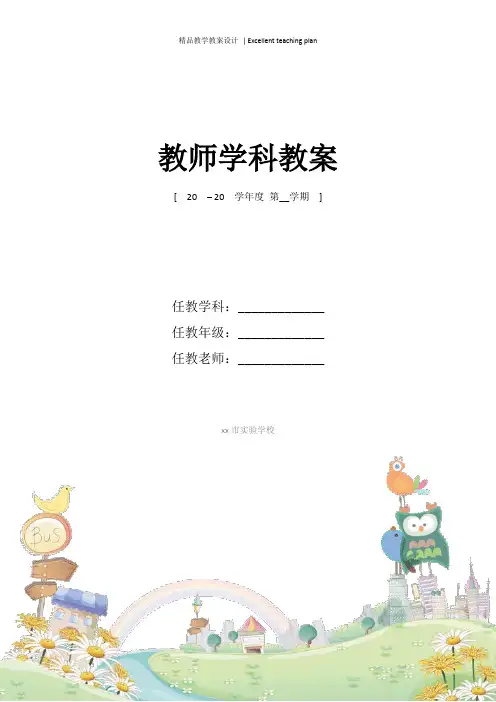
教师学科教案[ 20 – 20 学年度第__学期]任教学科:_____________任教年级:_____________任教老师:_____________xx市实验学校Oxford English 2AModule 3 Unit 1 In the children’s gardenTopic: In the children’s gardenSub-topic:Period 1:Look and lear n﹠Look and sayPeriod 2:Ask and answer Listen and enjoy﹠ Learn the letters单元目标:一.知识目标:1.能够正确朗读单词slide, swing, seesaw。
2.能够运用特殊疑问句What can you see? What colour is it?进行提问并问答。
3.能够用句型I can see…来表达自己看到的事物。
二.能力目标1.通过pair work、看图问答等进行操练。
通过歌曲,对话,游戏等形式,用课文中提供的句型,让学生获取信息。
2.结合学生的能力,发挥他们的想象,模仿教师提供的儿歌编出不同的儿歌来。
3、通过多媒体让学生看看说说提高口头表达的能力。
三.情感目标:通过引导学生观察身边的生活环境,了解课外生活的美好,并且培养学生热爱大自然,享受大自然的情感。
单课时教学目标:单元文本设计:It’s a beautiful children’s garden.I can see a swing.It's orange.I can swing on the swing. It's very fun.I can see a slide.It's blue.I can slide on the slide. It's very fun.I can see a seesaw.It's red and yellow.I can play on the seesaw. It's very fun.教学过程设计:Period 1Period 2。
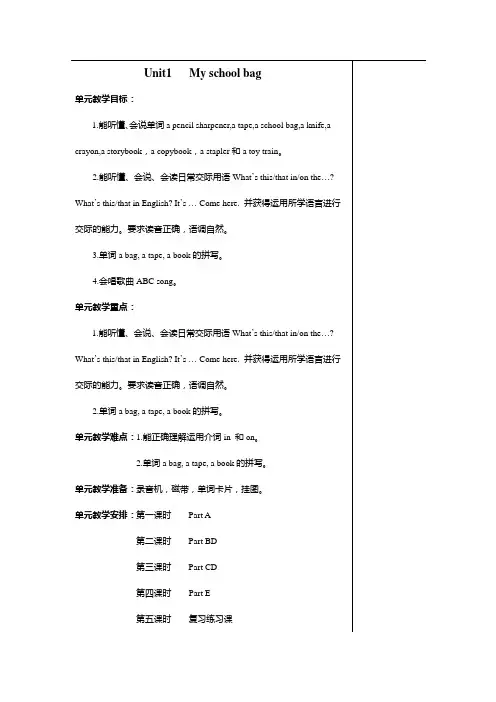
外研版三年级下册英语Module 3《Unit 1 I like football.》教案教材分析:本单元的教材主要围绕运动和喜好展开,通过介绍不同的运动项目,引导学生表达自己的喜好和不喜欢的事物。
教材内容简单生动,适合三年级学生的学习能力和兴趣。
教学目标:知识与能力目标:1. 学生能够听、说、读、写以下单词:like, football, basketball, table tennis, don't, morning exercises。
2. 学生能够运用句型“I like…”和“I don't like…”来表达自己的喜好。
3. 学生能够听说理解课文内容。
情感目标:1. 加强体育锻炼,强身健体的意识。
2. 培养学生坚持到底的恒心和意志力。
教学重点和教学难点:重点:1. 在日常生活中能灵活运用句型“I like…”和“I don't like…”来表达自己的喜好。
2. 掌握新单词的读音和拼写。
难点:1. 单词 "exercises" 的发音。
学情分析:学生是三年级的学生,他们对于自己的喜好和不喜欢已经有一定的认知和表达能力。
他们对于运动项目也有一定的了解。
但在发音方面,他们可能会遇到一些困难。
教学过程:一、导入1. 教师与学生打招呼,营造良好的学习氛围。
可以说:“Good morning, class! How are you today? I hope you're all feeling great and ready for our English lesson!”2. 师生互动:教师用图片或实物引导学生谈论自己的喜好,如 "Do you like football? What sports do you like?"教师可以展示一张图片或拿着一个足球,并问学生:“Do you like football? Who likes football? Raise your hand if you like football.”然后选择几个学生回答:“Yes, I like football.”或“No, I don't like football.”接着问:“What sports do you like? Can you tell me?”鼓励学生用完整的句子回答。
单元课程设计教案【单元课程设计教案】一、教学目标在本单元学习中,学生将能够:1. 掌握与单元主题相关的词汇和短语;2. 了解单元主题的背景知识;3. 听懂并能正确使用有关单元主题的句子;4. 运用所学知识进行简单的口语表达。
二、教学重点1. 单词与短语的掌握;2. 句型的学习与运用。
三、教学内容Unit 1: My Hobbies1. 词汇与短语hobby, painting, swimming, playing chess, collecting stamps, photography, singing, dancing2. 句型- What's your hobby?- My hobby is painting.- I love swimming.- Do you like playing chess?- Yes, I do. / No, I don't.- Can you show me your stamp collection?- Sure, here it is.- I enjoy photography.- She likes singing and dancing.四、教学过程Step 1: 词汇导入介绍并教授本单元涉及的词汇与短语,包括hobby, painting, swimming, playing chess, collecting stamps, photography, singing, dancing 等。
Step 2: 听力训练播放相关对话或短文,让学生集中注意力并尝试听懂对话内容。
随后进行简单的听力理解问题评测,确保学生对听力材料理解正确。
Step 3: 句型练习引导学生使用所学句型进行对话练习。
例如,两人一组,他们可以互相询问对方的兴趣爱好,并回答相应问题。
Step 4: 角色扮演让学生分成小组,每个小组选择一个角色,通过对话形式展示该角色的兴趣爱好。
一、教学目标1. 知识与技能:通过学习本单元,使学生能够掌握基本的词语、句子和段落,提高学生的阅读理解能力,培养学生的文学素养。
2. 过程与方法:通过自主学习、合作学习和探究学习,使学生掌握学习方法,提高学习效率,培养学生的合作意识和探究精神。
3. 情感态度价值观:通过学习本单元,使学生能够感受到文学的魅力,培养学生的审美情趣,激发学生对生活的热爱。
二、教学内容本单元主要包括以下内容:1. 词语学习:通过学习本单元,使学生掌握一定数量的词语,提高学生的词汇量。
2. 句子学习:通过学习本单元,使学生能够理解句子结构,提高学生的句子表达能力。
3. 段落学习:通过学习本单元,使学生能够理解段落结构,提高学生的段落表达能力。
4. 阅读理解:通过学习本单元,使学生能够理解文章内容,提高学生的阅读理解能力。
5. 文学欣赏:通过学习本单元,使学生能够感受到文学的魅力,培养学生的文学素养。
三、教学重点与难点1. 教学重点:词语学习、句子学习、段落学习、阅读理解、文学欣赏。
2. 教学难点:句子结构、段落结构、阅读理解、文学欣赏。
四、教具与学具准备1. 教具:教材、PPT、黑板、粉笔等。
2. 学具:笔记本、笔、字典等。
五、教学过程1. 导入:通过图片、视频等方式导入新课,激发学生的学习兴趣。
2. 新课内容学习:通过讲解、示范、练习等方式,使学生掌握词语、句子、段落、阅读理解、文学欣赏等方面的知识。
3. 巩固练习:通过练习题、小组讨论等方式,巩固所学知识,提高学生的实际应用能力。
4. 课堂小结:总结本节课所学内容,强调重点和难点,布置作业。
六、板书设计1. 统编版语文三年级下册第一单元2. 内容:词语学习、句子学习、段落学习、阅读理解、文学欣赏七、作业设计1. 词语练习:抄写本节课所学的词语,并用词语造句。
2. 句子练习:仿写本节课所学的句子,提高句子表达能力。
3. 段落练习:仿写本节课所学的段落,提高段落表达能力。
单元教学设计模板一、教学目标本教学设计旨在帮助学生掌握某一特定单元的知识和技能,使学生能够在实际应用中灵活运用所学知识。
具体教学目标如下:1.知识目标:通过本单元的学习,学生将了解相关概念、原理和理论,并能够准确描述和解释。
2.能力目标:学生将培养相关的思维能力和实践操作技能,能够解决与该单元相关的问题和情境。
3.情感目标:培养学生的兴趣和主动性,激发他们对所学知识的兴趣和乐趣,增强学生对科学的好奇心和探索欲望。
二、教学内容本单元的教学内容为某一特定主题或领域的知识和技能。
包括以下几个方面:1.概念与原理:介绍相关概念、原理和理论,帮助学生建立起知识框架和基本认识。
2.实践操作:引导学生进行实践操作,如实验、实训或案例分析等,让学生亲自动手解决实际问题。
3.拓展应用:鼓励学生将所学知识应用于实际情境中,培养学生的综合应用能力和创新思维。
三、教学方法根据教学内容和目标,采用多种教学方法结合使用,以提高教学效果。
常用的教学方法包括以下几种:1.讲授法:通过讲解、示范和演示,向学生介绍相关概念和知识,帮助学生建立起基本的认知框架。
2.实践探究法:引导学生进行实践操作,激发学生的学习兴趣和主动性,培养他们的实践能力和解决问题的能力。
3.案例分析法:通过分析实际案例,帮助学生理解所学知识的应用场景和实际意义,培养学生的分析和判断能力。
4.合作学习法:鼓励学生互相合作、交流和讨论,共同解决问题,提高学生的团队合作能力和沟通能力。
5.评价反馈法:及时对学生的学习情况进行评价和反馈,帮助学生发现并纠正问题,促进他们的进一步提高。
1.导入阶段:引入本单元的主题和目标,激发学生的兴趣和好奇心,建立起学生对本单元的初步认识。
2.知识传授和巩固阶段:通过讲授、示范和演示,向学生介绍相关的知识和技能,并引导他们进行学习巩固。
3.实践操作和探究阶段:安排学生进行实践操作和探究活动,让学生亲自动手解决问题,培养他们的实践能力和动手操作技能。
English 3B (Oxford Shanghai Edition)Module 2 Unit 1 AnimalsI、单元教学目标A. Language knowledge (语言知识):1. 能正确认读和拼写tiger, lion, panda, monkey这四个动物单词。
2、能较熟练地在语境中运用They are… They have … They can … They like …描述动物特征和能力以及喜好。
3、能运用句型Do you like…? Yes, I do./No, I don’t.等,来熟练表达自己的喜好。
4、可以感知动词短语climb the tree, water the flowers, run fast, ride bicycles,play the guitar, play hoops等在语境中的含义。
5、能理解拓展句型What do you like? I like … Why? 在语篇中的含义,并且可以根据语境利用新授句型进行简单的仿说和表达。
B. Language skills (语言技能):Listening:1、能听懂动词短语climb the tree, water the flowers, run fast, ride bicycles,play the guitar, play hoops和主要句型Do you like…? Yes, I do./No, I don’t.和What do you like? I like …2、能听懂单词tiger, lion, panda, monkey3、能听懂并理解文本Monkeys and hats的内容。
Speaking:1、能较熟练地在语境中运用They are… They have … They can … They like …在语篇中描述动物。
2、能较熟练地在语境中说出单词tiger, lion, panda, monkey。
English 3B (Oxford Shanghai Edition)Module 2 Unit 1 AnimalsI、单元教学目标A. Language knowledge (语言知识):1. 能正确认读和拼写tiger, lion, panda, monkey这四个动物单词。
2、能较熟练地在语境中运用They are… They have … They can … They like …描述动物特征和能力以及喜好。
3、能运用句型Do you like…? Yes, I do./No, I don’t.等,来熟练表达自己的喜好。
4、可以感知动词短语climb the tree, water the flowers, run fast, ride bicycles,play the guitar, play hoops等在语境中的含义。
5、能理解拓展句型What do you like? I like … Why? 在语篇中的含义,并且可以根据语境利用新授句型进行简单的仿说和表达。
B. Language skills (语言技能):Listening:1、能听懂动词短语climb the tree, water the flowers, run fast, ride bicycles,play the guitar, play hoops和主要句型Do you like…? Yes, I do./No, I don’t.和What do you like? I like …2、能听懂单词tiger, lion, panda, monkey3、能听懂并理解文本Monkeys and hats的内容。
Speaking:1、能较熟练地在语境中运用They are… They have … They can … They like …在语篇中描述动物。
2、能较熟练地在语境中说出单词tiger, lion, panda, monkey。
3、能熟练地运用句型Do you like…? Yes, I do./No, I don’t.等,来熟练表达自己的喜好。
Reading:能较熟练的朗读主文本。
Writing:能在课后尝试完成写作My favourite animal。
C. Language use (语言应用):1. 能够使用正确的单词来描述动物名称。
2. 能够使用Do you like…?句型来询问他人的喜好。
3. 能够用Yes, I do./ No, I don’t 句型来回答自己的喜好。
4. 能够使用They’re…They can…描述动物的外型、特点及能力。
5.能够正确使用语段来对动物的外型、食性、能力、特点进行全面描述。
D. Cultural consciousness(文化意识):了解中国传统文化中的动物形象,明白动物与人类生活息息相关。
E. Affection and attitudes (情感态度):通过对话、故事表演、小组讨论等形式了解动物的形态和各自的本领,进而产生关爱动物、善待动物之意,体会人与动物和谐共处之境。
II、分课时教学目标III、单课教学文本与教学过程Period 1 Animals in the zooSchool: Zijing Primary School of Jiading District (嘉定区紫荆小学)Teacher: Lillian (李琳)Teaching materials:主体文本Animals in the zooHello, I’m Mr Monkey. Welcome to the zoo. There are many animals in it. I can see the monkeys. They’re small. They’re brown. They can climb the tree. They can swim. They like eating bananas. The pandas are big. They’re black and white. They can climb the tree too. They like eating bamboos. The hippos are big. They can swim. They like eating grass. I can see the elephants. They’re so big. They’re grey. They can water the flowers. They like eating hay. I can see the lions. They can run fast. They like eating meat.辅助文本Welcome to the Monkey Mountain. They’re my good friends. They are brown. They can climb the tree. They can swim too. They like eating bananas.I can climb the tree. Look, they’re my friends too. They’re big, but they can climb the tree too. They like eating bamboos.I can swim. My friends can swim too. So we can swim together. They’re so big. They like eating grass. Look, they’re swimming in the river.Oh, it’s so hot. They’re my friends. They like eating hay. They have long noses. They can water the flowers. So I can take a shower now.It’s cool now. Oh! Can you hear this voice? It’s scary. They are big. They like eating meat. They can run fast. I can’t run fast. But they can teach me. So they’re my friends.教学设计说明:本课的教学内容为牛津英语3B Module 2 Unit 1 Animals中的第一课时,基于对单元的整体设立,第一课时的主题为: Animals in the zoo。
本课时的重点是让学生能从动物的形态大小、颜色、与生俱来的能力以及喜爱的食物四方面来描述自己所喜爱的动物。
教学的重点句型为:What animals do you like? 让学生能够询问他人对动物的喜好,并能用I like…来表达自己的喜好。
由于学生本身对动物这一话题怀有极大的兴趣,所以学生们的学习兴趣较为浓厚。
在本课的教学中,我将努力把握以下几点:一、创设合理情境,激发学生学习兴趣研究表明:小学阶段正是情感性学习形成的关键时期。
这阶段学生的学习活动带有很大程度的情绪倾向,每当学生对学习有浓厚的兴趣、好奇心和强烈求知欲时,他们不仅能产生情感迁移,而且他们的注意力会特别持久和集中。
所以如何吸引学生的注意力,激发学生的学习兴趣,是需首要解决的问题。
悦耳动听的音乐、生动活泼的图片、趣味横生的游戏,在很大程度上都能吸引学生的学习兴趣。
通过预设Mr Monkey这一主线人物,创设Mr Monkey带领我们游览动物园这一情境,通过他对朋友的描述过程中,让学生们听一听,说一说,从而了解不同的动物。
穿插guessing game这一环节,让学生在在玩中学,既能激起学生的兴奋点,又能在轻松愉快的氛围中,把学生的情绪转移到英语上来,帮助学生体验主题,激发学生交流的兴趣。
二、立足文本再构,调动学生语用情趣心理学研究表明:小学生的思维在很大程度上还主要是依靠直观的、具体的内容。
为了更好地发展学生的语言运用能力,适当进行再构文本,围绕着主题,运用各种辅助文本,结合听、说、读三点要求,循序渐进地开展教学活动。
力求通过本课的学习学生们能够完整的描述出动物的形态大小、颜色、能力及喜爱的食物,表达自己喜爱的动物。
在学习过程中能调动学生想说、要说的情趣,最终达到语用的目的。
Period 2 Animals in the circusSchool: Zijing Primary School of Jiading District (嘉定区紫荆小学)Teacher: Jojo (张卓)Teaching materials:主体文本In the circusWelcome to the circus. We can see many animals in it.Look at the tigers. They are big. They’re orange and black. They can dance. They can play with the ball. They can jump through(穿过) hoops. They are super. The birds are small and colourful. They can sing. They can ride bicycles. They’re lovely!They can make us happy. Do you like them?辅助文本1、H ello, I’m Mr Monkey. Welcome to the circus. There are many animals in it.They’re my friends.2、L ook at the monkeys. Th ey’re brown. They’re small. They can sing in the circus.They can ride bicycles. They can play the guitar. They’re clever!3、L ook at the elephants. They’re grey. They’re strong. They can pl ay basketball inthe circus.They can play football in it. They can dr aw. They’re super!I likeelephants best. Do you like elephants?4、L ook at the bears. They’re black. They’re strong. They can dance in the circus.They can play hoops in it. They can ride bicycles. They’re smart!教学设计说明:本课的教学内容为牛津英语3B Module 2 Unit 1 Animals中的第二课时,基于对单元的整体设立,第二课时的主题为:Animals in the circus。